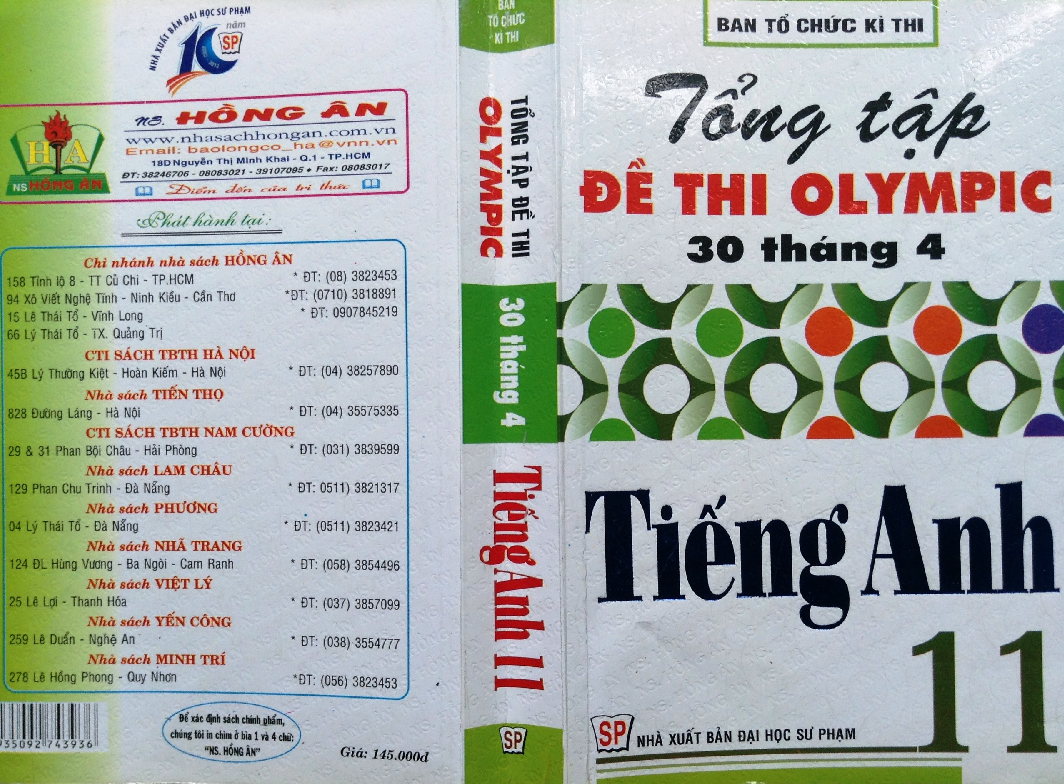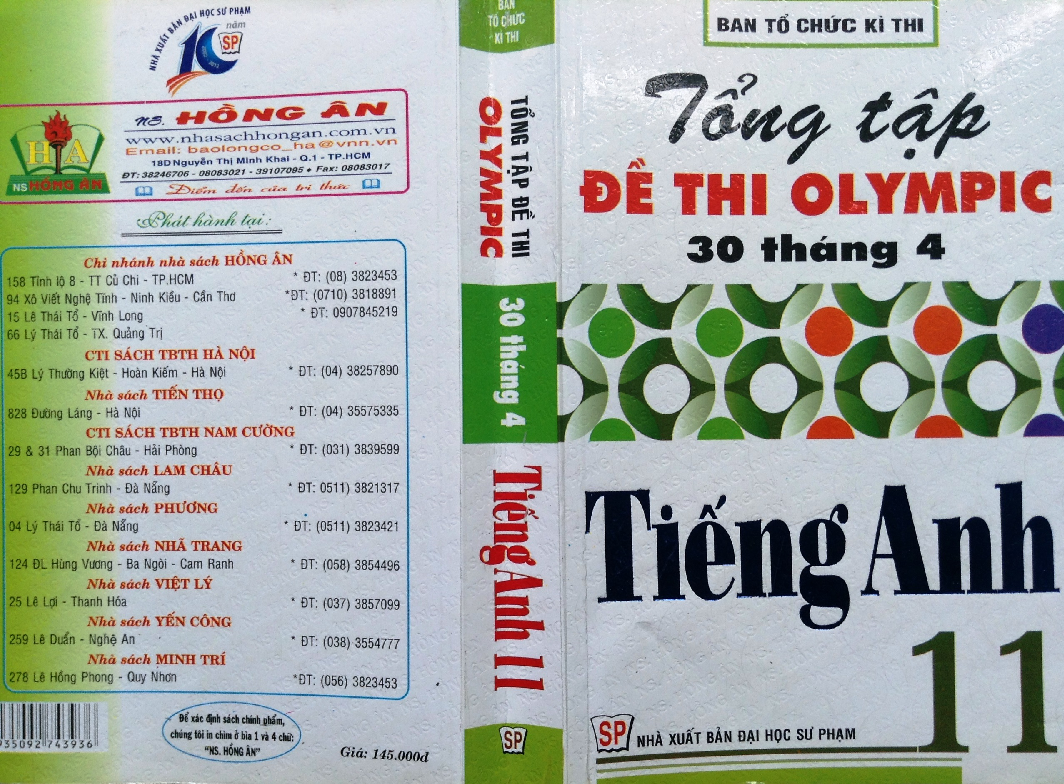







Preview text:
blogchuyenanh.wordpress.com
SỞ GIÁO DỤC VÀ ĐÀO TẠO TP. HCM TRƯỜNG THPT CHUYÊN LÊ HỒNG PHONG KÌ THI OLYMPIC 30 THÁNG 4
Môn thi: TIẾNG ANH – LỚP 10 LẦN XVII - 2011
_____________________________________________________________________________________
PART A. MULTIPLE CHOICE QUESTIONS (60 POINTS).
I. PHONOLOGY (10 POINTS).
A. Pick out the word whose underlined part is pronounced differently from that of the others. 1. A. ecotourism B. olive C. omelet D. toddle 2. A. sidle B. thigh C. expertise D. umpire 3. A. chlorophyll B. chloride C. lichen D. chaperone 4. A. cursed B. ragged C. crooked D. accoutered 5. A. accredit B. salamander C. majesty D. saliva
B. Stress: Choose the word whose stress pattern is different from that of the others. 6. A. contribute B. tsunami C. tornado D. category 7. A. reservoir B. painstaking C. quinquina D. camera 8. A. gasometer B. agriculture C. nostalgic D. enthronement 9. A. introduce B. Japanese C. technological D. photography 10. A. European B. pneumonia C. Aborigine D. ingenuity
II. VOCABULARY & STRUCTURES (20 POINTS).
1. Linda is married _____ three children. A. to B. at C. with D. of 2. I am slow to _____. A. express my opinion
B. express my viewing C. make my views D. make my opinion
3. The car was parked directly _____ the diner. A. before B. ahead of C. in front of D. preceding
4. It is already 3 o’clock. Can you _____ time to catch the bus?
A. have enough B. have it in
C. make in D. make it in
5. The burning stick was very hot. He let _____ just in time. A. alone it B. go alone it C. go it D. go of it
6. Did you really pay $1,000 for that normal painting? I think you were _____. A. robbed off B. ripped off
C. turned off D. broken off
7. We saw _____ wild animals while on vacation. A. quite a few
B. quite much C. quite many D. quite some
8. “David is still somewhat new and inexperienced in the job. He’s a what you call “a _____”. Well give him
a few more weeks and I’m sure he’ll be Okay,” George said to one of his other colleagues.
A. green eye B. greenhorn C. green finger D. new leaf
9. Are you shopping for _____ health club to join so you can get in shape? A. a B. an C. the
D. no article is needed
10. I love to do things for children because I get a _____ out of it. A. pass B. shoot C. kick D. move
11. Rowen _____ for joy when she heard that she’d won the first prize. A. came B. burst C. moved D. jumped
12. You won ten pounds on lottery. _____! A. Big thing B. Big deal C. Big D. Big job
13. She’d go to the ends of _____ to save her children. A. the earth B. the house C. the life D. the world
14. He started talking about the cost of a new computer, which was a _____ herring because we’ve got plenty of computers. A. blue B. red C. black D. green
15. When I first saw Pat, my heart _____ a beat. I knew he would be important to me. A. lost B. failed C. missed D. skipped Page 1 of 8 blogchuyenanh.wordpress.com
16. She always _____ to great lengths to make us feel welcome. A. goes B. jumps C. enters D. flies
17. Janet will see you if you use the computer without permission. She has eyes like a _____. A. bird B. goose C. hawk D. fox
18. Go on. Tell me the gossips. I’m all _____. A. full B. head C. eyes D. ears
19. I _____ in to see Chris on my way home. A. joined B. dropped C. plugged D. put
20. You must be careful when you wash this _____ silk blouse. A. weak B. sensitive C. delicate D. feeble
III. READING COMPREHENSION (20 POINTS). PASSAGE 1
Even before the turn of the century, movies began to develop in two major directions: the realistic and
the formalistic. Realism and formalism are merely general, rather than absolute, terms. When used to
suggest a tendency toward either polarity, such labels can be helpful, but in the end they are just labels.
Few films are exclusively formalist in style, and fewer yet are completely realist. There is also an important
difference realism and reality, although this distinction is often forgotten. Realism is a particular type,
whereas physical reality is the source of all the raw materials of film, both realistic and formalistic. Virtually,
all movie directors go to the photographable world for their subject matter, but what they do with this
material- how they shape and manipulate it- determines their stylistic emphasis.
Generally speaking, realistic films attempt to reproduce the surface of concrete reality with a minimum
of distortion. In photographing objects and events, the filmmaker tries to suggest the copiousness of life
itself. Both realist and formalist film directors must select (and hence emphasize) certain details from the
chaotic sprawl of reality. But the element of selectivity in realistic films is less obvious. Realists, in short, try
to preserve the illusion that their film world is unmanipulated, an objective mirror of the actual world.
Formalists, on the other hand, make no such pretense. They deliberately stylize and distort their raw
materials so that only the very naive would mistake a manipulated image of an object or event for the real thing.
We rarely notice the style in a realistic movie; the artist tends to be self-effacing. Some filmmakers are
more concerned with what is being shown than how it is manipulated. The camera is used conservatively. It
is essentially a recording mechanism that produces the surface of tangible objects with as little commentary
as possible. A high premium is placed on simplicity, spontaneity, and directness. This is not to suggest that
these movies lack artistry, however, for at its best the realistic cinema specializes in art that conceals art.
1. What does the passage mainly discuss? A. Acting styles B. Film plots
C. Styles of filmmaking D. Filmmaking 100 years ago
2. With which of the following statements would the author be most likely to agree?
A. Realism and formalism are outdated terms.
B. Most films are neither exclusively realistic nor formalistic.
C. Realistic films are more popular than formalistic ones.
D. Formalistic films are less artistic than realistic ones.
3. The phrase "this distinction" in the first paragraph refers to the difference between _____.
A. formalists and realists B. realism and reality
C. general and absolute
D. physical reality and raw materials
4. Whom does the author say is primarily responsible for a style of a film? A. The director B. The actors C. The producer D. The camera operator
5. The word "it" in the first paragraph refers to _____.
A. the photographable world
B. their subject matter C. this material
D. their stylistic emphasis
6. The word "copiousness" in the second paragraph is closest in meaning to _____. A. abundance B. greatness C. fullness D. variety
7. How can one recognize the formalist style?
A. It uses familiar images.
B. It is very impersonal.
C. It obviously manipulated images.
D. It mirrors the actual world.
8. The word "tangible" in the last paragraph is closest in meaning to _____. A. concrete B. complex C. various D. comprehensible Page 2 of 8 blogchuyenanh.wordpress.com
9. The word "self-effacing" in the last paragraph is closest in meaning to _____. A. modest B. shy C. egocentric D. introverted
10. Which of the following films would most likely use a realist style?
A. A travel documentary B. A science fiction film C. A musical drama D. An animated cartoon PASSAGE 2
Whether it’s the melodic sound of an Eric Clapton solo or the growl of a heavy metal band, the electric
guitar has influenced popular music and culture more than any other instrument. Rock’s greatest musicians
have always been closely identified with their guitars. But the instruments being designed for tomorrow’s
pop stars may look and sound rather different from today’s familiar electric and acoustic guitars.
It is only sixty years since the electric guitar was invented. Since then there have been incredible
changes to the technical design of the instrument. From what was once a rounded wooden box with a hole
in the front, the guitar has evolved into the smooth solid body of the rock guitarist’s “axe”. The most modern
guitars are really computer-controlled synthesizers.
Adolph Rickenbacker’s Electro String Company produced the first world’s first electric guitar. It was
made of wood and played on the user’s lap. The first real breakthrough in design came in 1950 when Leo
Fender, a California radio repairman, made the first solid-bodied electric guitar, the Fender Telecaster.
Soon after the inventor Les Paul made the famous Gibson Les Paul, Fender launched his stylish
Stratocaster two years later. These guitars became standard instruments against which newer guitar designs are measured.
All sorts of different materials have been used to make guitars. Acoustic guitars are made from wood,
which gives a soft tone. Wood is also a popular material in electric guitar manufacture, but more modern
material such as glass and carbon fibre are also used. There have also been guitars with metal bodies and
necks though these were never popular with players, who claim metal feels cold in the hand.
Plastics, on the other hand, have been more used in guitar bodies. A company that makes parts for the
aerospace industry has begun to use a kind of fiberglass that was originally used in helicopter blades to
make the bodies for its electric-acoustic instruments. Other makers have begun to experiment with
graphite, which is ten times stiffer than wood but much lighter. It doesn’t expand or contact as the
temperature or humidity changes either. This makes it particularly suitable for guitar necks and for tennis
rackets, for which it is also used.
As long as scientists and musicians work together harmoniously, the electric guitar will continue to
benefit from technological innovations. But for all the efforts of the guitar companies’ design engineers,
managers and quality controllers, it’s the musicians who finally make the instruments sing – and not
necessarily in the way the guitar maker intended.
1. What is likely to change in the future?
A. The influence of the guitar on popular culture
B. Styles of guitar music
C. The guitars themselves
D. How musicians feel about their guitars
2. The first electric guitar was _____. A. computer-controlled B. played sitting down C. not hollow inside
D. designed by Leo Fender
3. The guitars designed in the fifties _____. A. were unsuccessful
B. are often compared to guitars designed today C. were made of wood
D. were played sitting down
4. Which material was disliked by musicians? A. Metal B. Wood C. Plastic D. Carbon fibre
5. Why is graphite a good material for guitar necks?
A. It has been used for tennis rackets.
B. It is heavier than wood.
C. It is more flexible than wood.
D. It is not affected by atmospheric conditions.
6. Recent technological innovations _____.
A. have not really improved the electric guitar
B. have been ignored by musicians
C. cannot determine the way the guitar will be played
D. are not what musicians hoped for
7. Which one of the following subjects is not referred to:
A. Companies that make guitars
B. Materials guitars are made of
C. The role of technology
D. Other musical instruments Page 3 of 8 blogchuyenanh.wordpress.com
8. The writer uses the word “guitar” sixteen times in the passage. What other word(s) is/are used instead of “guitar”? A. Axe B. Instruments C. Both of them D. None of them
9. How many materials are mentioned? A. 4 B. 5 C. 6 D. 7
10. What can be the best title of the passage? A. Guitar Industry B. Guitar Legends C. Guitar Stories D. Guitar Makers
IV. GUIDED CLOZED (10 POINTS).
AN ORANGE DAY KEEPS THE DOCTOR AWAY
Most people today know how important it is to have a (1) _____ diet. If for some reason this is not
possible we have available to us a wide (2) _____ of dietary supplements including vitamins and minerals.
One of the earliest researchers to recognize the role of dietary deficiencies (3) _____ in disease was the
Scottish surgeon, James Lind. Lind analyzed the diets of thousands of British sailors who had taken long
sea voyages and discovered that they ate (4) _____ or no fresh fruit such as lemons or oranges. He (5)
_____ to the conclusion that a lack of these fruits led to the disease (6) _____ as “scurvy”. Scurvy has
occurred (7) _____ human history during times of warfare and famine when people could not get fresh
foods like fruit, vegetables and meat. However, when Europeans began to make long voyages of
exploration in the fifteenth and sixteenth centuries the problem (8) _____ more acute. By the eighteenth
century, more sailors were dying of scurvy on British ships than as a result of warfare. Lind proved his
theory by (9) _____ the crew of one ship with a supply of fresh lemon juice and comparing the health of the
sailors at the end of a long voyage with a second crew that had had only conventional meals. Many of this
second group of sailors developed scurvy while the crew who had had (10) _____ to the lemon juice were healthy. 1. A. equal B. even C. careful D. balanced 2. A. range B. collection C. set D. series 3. A. do B. make C. play D. affect 4. A. little B. few C. scare D. less 5. A. reached B. came C. arrived D. got 6. A. called B. named C. known D. well-known 7. A. along B. over C. in D. throughout 8. A. turned B. turned out C. came D. became 9. A. providing B. giving C. delivering D. bringing 10. A. access B. right C. permission D. admission PART B. WRITTEN TEST.
I. VERB TENSES AND VERB FORMS.
1. The little girl accompanied by her cats and dogs __________ (WANDER) in the back yard at midnight the other night.
2. Not only the Smiths but also Mr. Brown (NOT, RECEIVE) __________ any support of late.
3. Neither my colleagues nor I (BE) __________ particularly interested in the training course next month.
4. You (NOT, GO) __________ there as she was not expecting you.
5. It is desirable that the systems we develop in-house (BE) __________ compatible with those in use elsewhere.
6. I’ll try phoning him but he __________ by now. (GO OUT)
7. The weather __________ (BE) bad, they couldn’t but __________ (CANCEL) the camping trip.
8. The huge damage __________ (NOW, REPORT) __________ (CAUSE) by the recent violent earthquake.
II. FILL IN THE BLANK WITH A SUITABLE PREPOSITION OR PARTICLE.
1. __________ the photographs are two taken in Phong Nha in 1960.
2. Attach a recent photograph __________ your application form.
3. Roger took painting __________ for a while, but soon lost interest.
4. People thought that the use of robots would do __________ with boring low-paid factory jobs.
5. The jury was unable to bring __________ a verdict on the remaining six defendants.
6. Pour half a pint of milk __________ a small pan and warm it gently. Page 4 of 8 blogchuyenanh.wordpress.com
7. Eating good food is good insurance __________ sickness.
8. Everyone can use the cafeteria, from the managing director __________ to the office boy.
9. Several of the employees __________ him complained of his bullying behavior.
10. Don’t come __________ hard on the new workers.
III. ERROR IDENTIFICATION.
Malaria is caused by Plasmodium parasites that are carried and spread from human to human by
female Anopheles mosquitoes.
The World Health Organization (WHO) explains:
Transmission is more intensified in places where the mosquito is relatively long-lived (so that the
parasite has time completing its development inside the mosquito) and where it prefers to bite humans
rather than other animals. For example, the long lifespan and strong human-bitten habit of the African
vector species is the underlying reason why more than 85% of the world’s malaria deaths are in Africa.
When transmitting to a new host, Plasmodium sporozoites travel to the liver to mature. Once in the liver,
they differentiate and release daughter organisms called merozoites into the blood to infect red blood cells,
within which they duplicate further.
As the original host cells rupture, the parasites periodically invade fresh red blood cells, causing waves
of symptoms like high fever, chills, diarrhea, vomiting, headaches and profuse sweating. The first
symptoms typically emerge 10 days to 4 weeks after infection, but have been known to appear as early as 8 days or up to a year later.
With two types of malaria parasites, a dormant stage called hypnozoites can persist in the liver and
cause relapses by invading the bloodstream weeks or years after infection.
Untreated malaria can be fatal. It kills more than 1 million people each year, 90% in sub-Saharan Africa.
The WHO reports that malaria counts for 20% of all child deaths in Africa, and which one African child dies
of the disease every 45 seconds. How do you prevent it?
You can put anti-malarial drugs before and after traveling to areas where malaria is prevalent. Get a
prescription well in advance, because treatment may begin up to 2 weeks before you travel, and continue
for a month after your return.
IV. OPEN CLOZE TEST (10 POINTS).
A snow leopard roars in the high mountains of Asia. A black rhinoceros gallops across the plains of
Africa. A grizzly bear hunts for fish in a North American river. A mother blue whale and her calf glide
through the deep waters of the ocean.
All of these animals share the Earth with us. They fascinate us (1) __________ their beauty, their
grace, and their speed. We love observing their behavior, and learning more about their habits. But (2)
__________ loving them is not enough. All of these animals are endangered. Many of them have gone forever.
What can you do to help endangered animals? Learn as much died, and without special care, they may
someday (3) __________ from the Earth. Why is it important to care for animals like these? One reason is
to protects the (4) __________ of life on Earth. Another reason is the beauty of the animals themselves.
Each pieces of animal is special. Once it is gone, it as you can about them. The more you know, the more
you can help. (5) __________ an effort to support zoos and wildlife groups. Many zoos breed endangered
animals, helping to ensure that they will continue to live on. Contribute to groups, such as the National
Wildlife Federation and the Sierra Club, that work hard to protect animals. You can also be a smart shopper
and never buy a (6) __________ that has been raised in the wilderness.
The world is made up (7) __________ many living things, and each thing is dependent on the others to
survive. (8) __________ we allow even one species on Earth to become extinct, it has an impact (9)
__________ other living things and changes our world. When we mention any endangered wild animals,
let’s (10) __________ that we never again have to say, “Gone forever.” Page 5 of 8 blogchuyenanh.wordpress.com
V. SENTENCE TRANSFORMATION (20 POINTS).
1. This bottle – opener is completely useless. (DEAD)
________________________________________________________________________________
2. This important person will pay an official visit to our village. (SHOT)
This ____________________________________________________________________________
3. I’m afraid that I cannot afford that car. (MEANS)
That car is _______________________________________________________________________
4. You haven’t done your homework, have you?
It’s about ________________________________________________________________________
5. Drinking too much will affect your health. (TELL)
Drinking too much _________________________________________________________________
6. Laughing isn’t permitted in the pagoda.
You must keep ____________________________________________________________________
7. Their problems are all self-inflicted.
Their problems are of _______________________________________________________________
8. We will not delay our voyage whether there is a rain or not.
Regardless ______________________________________________________________________
9. He pretended that his latest business failure was not important.
He laughed ______________________________________________________________________
10. Kate soon calmed down and explained her problem.
Kate soon pulled __________________________________________________________________ THE END OF THE TEST Page 6 of 8 blogchuyenanh.wordpress.com ANSWER KEY PART A I. A. 1. A 2. C 3. D 4. D 5. C B. 6. D 7. C 8. B 9. D 10. B II. 1. C 5. D 9. A 13. A 17. C 2. A 6. B 10. C 14. B 18. D 3. C 7. A 11. D 15. C 19. B 4. D 8. B 12. B 16. A 20. C III. PASSAGE 1 1. C 3. B 5. C 7. C 9. A 2. B 4. A 6. A 8. A 10. A PASSAGE 2 1. C 3. B 5. D 7. D 9. C 2. B 4. A 6. C 8. C 10. B IV. 1. D 3. C 5. B 7. D 9. A 2. A 4. A 6. C 8. D 10. A PART B I.
1. was wandering 5. should be
2. hasn’t received
6. may have gone out 3. am
7. being – cancel
4. shouldn’t have gone
8. is now reported – to have been caused II. 1. among 3. up 5. in 7. against 9. under 2. to 4. away 6. into 8. down 10. down III.
1. intensified intense
6. getting causing
2. completing to complete 7. as like
3. human-bitten human-biting
8. counts accounts
4. transmitting transmitted
9. which that
5. duplicate multiply
10. put take (… anti-malarial drugs…) Page 7 of 8 blogchuyenanh.wordpress.com IV. 1. with 4. balance/ 6. pet 9. on 2. just/ only diversity 7. of 10. hope/ believe 3. disappear 5. make 8. If V.
1. This bottle-opener is a dead loss.
2. This big shot will pay an official.
3. That car is beyond my means.
4. It’s about time you did your homework.
5. Drinking too much will tell on your health / tell on you.
6. You must keep a straight face in the pagoda.
7. Their problems are of their own making.
8. Regardless of the rain, we will not delay voyage.
9. He laughed off his latest business failure.
10. Kate soon pulled herself together and explained her problem. Page 8 of 8




